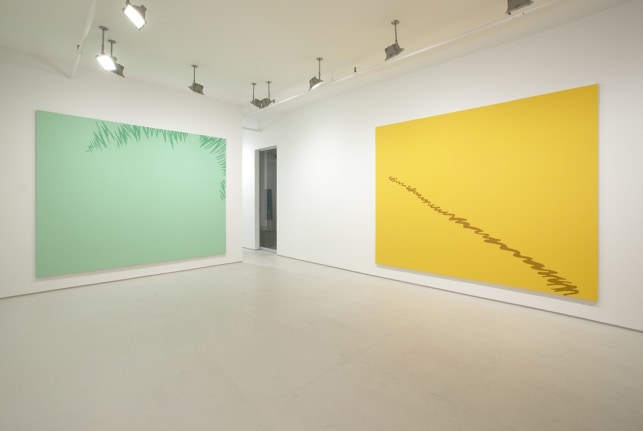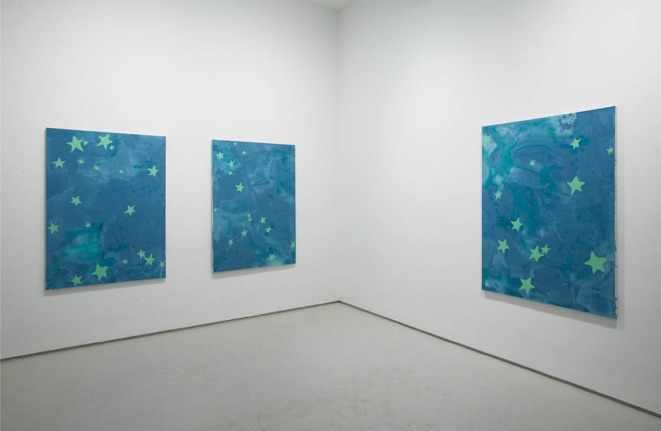FOR IMMEDIATE RELEASE
Carl Ostendarp April 3–May 8, 2004
Elizabeth Dee is pleased to announce an exhibition of new paintings by Carl Ostendarp in the gallery at 545 West 20th Street. There will be an opening reception for the artist on Saturday, April 3, from 6 to 8 pm.
In January of 1945, Pierre Matisse Gallery in New York opened a show of Joan Miró’s Constellations. These works in gouache and oil on paper were the artist’s escapist response to the growing horrors of war during the early 1940s. On washy, nearly opalescent grounds, a linear web of motifs—stars, moons, birds, eyes, whiskers, spirals, dots, squares, and triangles— mirrors the luminous tracks of constellations in a clear night sky. The Constellations are calligraphic and magical, belying the pressures of reality that resulted in their creation. They were “the first sign to America that the war had not paralyzed all of European art. André Breton, exiled in New York, wrote that the exhibit opened a window for Americans to look onto ‘all the flowering trees that the distant storm might have spared.’”[i] The allover linear tracery of Miró’s works would prove to be as influential as his oneiric landscapes of the 1920s with their inflected and metaphysical fields. Miró’s work hugely inspired the artists who would become the Abstract Expressionists, thus influencing generations of American abstract painting.
By 1962, Miró was well aware of what he had wrought and seems to have reflected upon his own legacy in a series of three monumentally sized Mural Paintings, one each in green, yellow-orange, and red. These works of vast fields of color inflected by only a few motifs, such as circles, dots, and irregular lines, can be seen both as a harking back to his own groundbreaking Surrealist compositions of the 1920s, as well as a consideration of an ascendant American Color Field painting. Miró spoke of his work from around this time as related to a direct experience of the heavens: "The spectacle of the sky overwhelms me. I'm overwhelmed when I see, in an immense sky, the crescent of the moon, or the sun. There, in my pictures, tiny forms in huge empty spaces. Empty spaces, empty horizons, empty plains—everything which is bare has always greatly impressed me."[ii] The Mural Paintings marked a kind of a turning point or a summation for Miró, as they constituted the last paintings he made for about a year, save for a single small canvas, as he concentrated on public commissions, ceramics, sculpture, and prints.
Carl Ostendarp, born in 1961, has long been intensely engaged with the history of modernist and abstract art. During the past decade and a half, he has mined sources as varied as Pollock’s drips, Newman’s zips, American color fields, Pop Art, and Surrealism, often all at the same time, to forge his own unique and influential brand of abstract-figurative painting. His love for aspects of popular culture has been equally ardent, and Dr. Seuss has been as potent an influence as Arp or Lichtenstein or the Sherwin-Williams paint sign. For the last year or so, he has pondered the pivotal year of 1962 and what he has called Miró’s “radically empty paintings,” produced at that moment by an elder European master regarding an upstart yet dominant American art form at the same time he contemplated his own achievement of forty years before.
Ostendarp’s new body of work comprises a series of three canvases scaled to the measurements (106 ¼ x 139 ¾ inches) of Miró’s Mural Paintings. While based on the works by Miró these new paintings are pure Ostendarp. These three grand cosmic statements are accompanied by a fourth painting, the same size (25 ½ x 31 ¾ inches) as the only other work Miró completed in 1962. A second series in this new body of work comprises six paintings after actual constellations, sized the same as Miró’s 1968 series called Letters and Numbers Attracted by a Spark (Lettres et chiffres attirés par une étincelle). Where Ostendarp’s three large paintings will evoke bright daylight skies, these six paintings (57 ½ x 44 ¾ inches each) will be nocturnes, six real constellations whose stars shimmer in atmospheric voids and become anthropomorphic as they twist and wave their pointed arms. The varied distortions of the stars and the liquid quality of the grounds also suggest the star-filled night skies as if reflected in water, appearing both on and under the surface like water lilies in a pond.
This will be Ostendarp’s ninth solo exhibition in New York and his second with Elizabeth Dee. In 2003 The Aldrich Museum of Contemporary Art presented a survey of his works on paper, and he was included in Art—A Sex Book by John Waters and Bruce Hainley.



